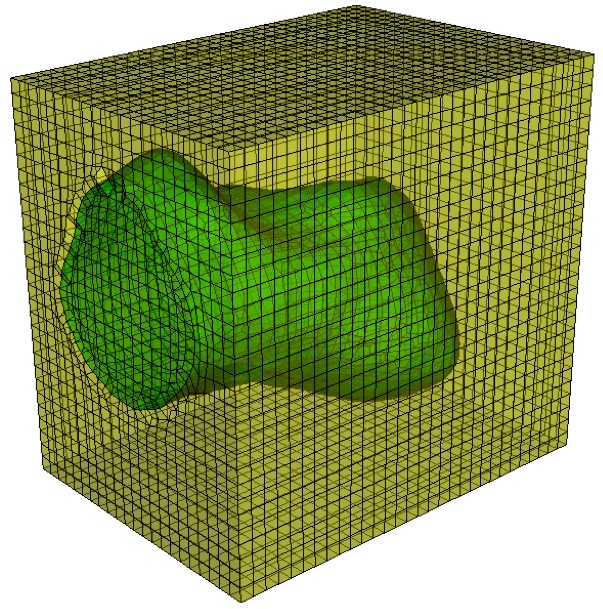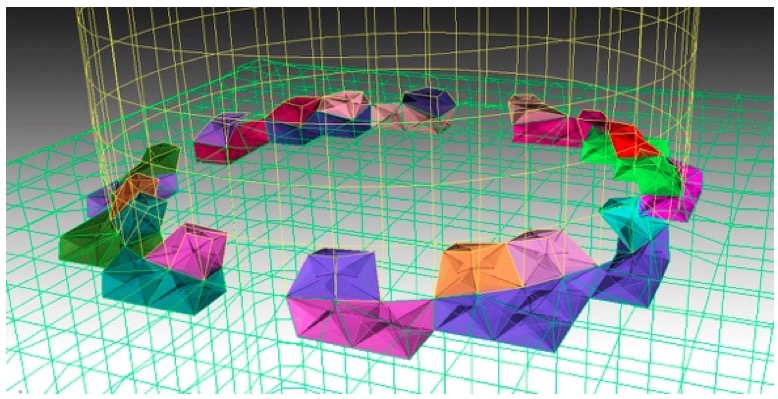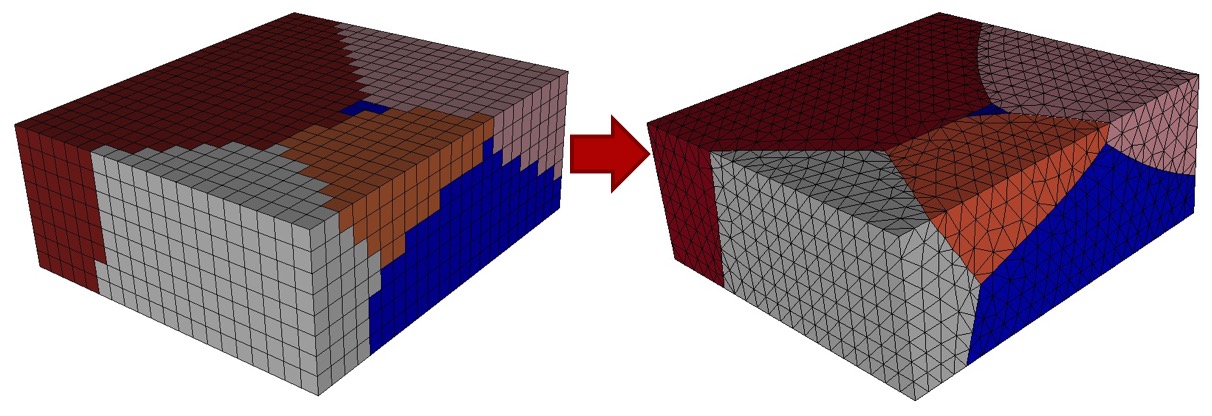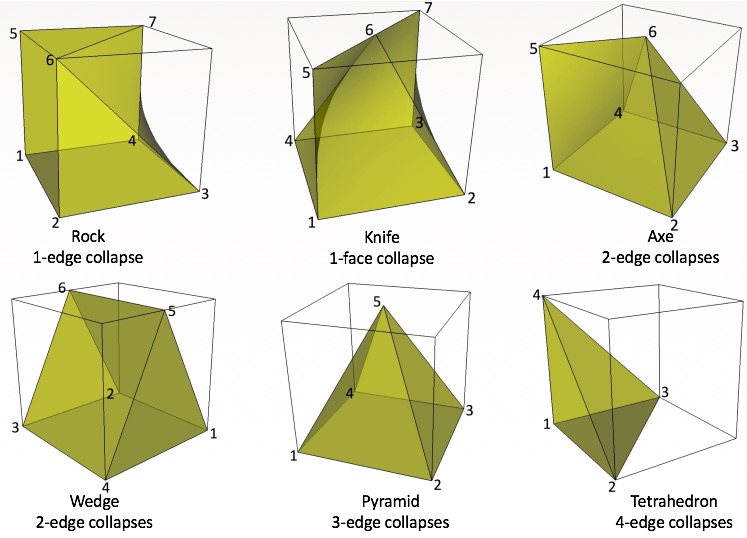Cubit
15.3 User
Documentation![]()
Cubit
15.3 User
Documentation![]()
Sculpt options for specifying the type of mesh that will be generated. The default mesh type that will be produced from Sculpt is an unstructured all-hex mesh that will attempt to conform as closely as possible to the input geometry. Sculpt will normally generate its mesh on the interior of the input geometry, however with the mesh_void option, it can also generate the mesh on the exterior of the geometry, out to the extent of the user-defined Cartesian overlay grid.
In addition to the default hex mesh, other types of meshes may be produced. This includes the stair-step mesh where the cells of the Cartesian grid inside or intersecting the geometry are used directly as the mesh without projections or smoothing. A triangle mesh may also be generated, which can be used as the basis for a facet-based geometry representation. Other methods include the capabilities to generate a hex-dominant mesh with hexes and tets as well as the ability to include degenerate elements.
Mesh Type --type -typ --stair, -str <args> Generate Stair-step mesh --mesh_void, -V Mesh void --htet, -ht <args> Convert hexes below quality threshold to tets --trimesh, -tri Generate tri mesh of geometry surfaces --deg_threshold, -dg <args> Convert hexes below threshold to degenerates --max_deg_iters, -dgi <args> Maximum number of degenerate iterations Sculpt Command Summary
Command: stair Generate Stair-step mesh
Long Name: --stair
Short Name: -str
Argument Type: integer (0, 1, 2, 3)
Input arguments: none (0)
off (0)
on (1)
full (1)
interior (2)
fast (3)
Command Description:

The stair option generates a stair-step mesh where the cells of the Cartesian grid are used in the final mesh without projection or smoothing to the material interfaces. Cells selected from the Cartesian grid to be used in the final mesh will have volume fraction greater than 0.5. Several different options for the stair argument are available:
off (0): Stair option is off (default)
full (1): Stair-step mesh is generated, but additional processing is done to ensure material interfaces are manifold. This option may add or subtract cells from the basic mesh (where volume fraction > 0.5) to ensure no non-manifold connections between nodes and edges exist in the final mesh.
interior (2): The exterior boundary will be smooth while internal material interfaces will be stair-step. This option also ensures manifold connections between elements.
fast (3): Generates the final mesh based only on volume fraction criteria. No additional processing is done to ensure manifold connections between edges and nodes.
Note: The stair-step option currently does not support generation of sidesets.
The -SS or --gen_sidesets option will be ignored when using the stair option.
Mesh Void
Command: mesh_void Mesh void Long Name: --mesh_void Short Name: -V Argument Type: none or true/falseCommand Description:

If mesh_void option is used, then the void space surrounding the geometry
will be treated as a separate material. Elements will be generated in the
void to the extent of the Cartesian grid boundaries. If void_mat option is
not used, the material ID of elements in the void region will be the
maximum material ID in the model + 1.
HTet
Command: htet Convert hexes below quality threshold to tets Long Name: --htet Short Name: -ht Argument Type: floating point value (-1.0 -> 1.0)Command Description:

Automatically generate tets in place of poor quality elements. This option can be used to eliminate poor quality hex elements by replacing each hex that falls below the user defined Scaled Jacobian with 24 tets. The 24 tets are formed by inserting one node at the center of each face and one on the interior. Default value for htet is -1.0. The result will be a non-conforming mesh at the interface between tets and hexes. A tied contact condition can be defined to ensure continuity of the neighboring tets and hexes. To facilitate this, one additional nodeset and sideset will be generated and output to the exodus file if the sideset option is specified.
Sideset 10000 = the set of hex faces that interface a set of 4 tets.
Nodeset 1000 = the set of nodes at the interface between hexes and tets.
One node per face in Sideset 10000 will be included.
Trimesh
Command: trimesh Generate tri mesh of geometry surfaces Long Name: --trimesh Short Name: -tri Argument Type: noneCommand Description:

Generate a triangle mesh of the surface geometry. Surface geometry will be defined based on input grid resolution as well as user defined smoothing smoothing parameters. Resulting exodus mesh will contain only TRI elements. All TRI elements will be assigned to the same block in the exodus file.
This option is most often used in conjunction with the --write_geom option used to build a mesh-based geometry in Cubit. Use the following command in Cubit to import a Sculpt trimesh exodus file and s2g file (produced from --write_geom)
import s2g <root filename>
See write_geom for more information on s2g files.
Command: deg_threshold Convert hexes below threshold to degenerates Long Name: --deg_threshold Short Name: -dg Argument Type: floating point value (-1.0 -> 1.0)Command Description:

Some geometries will not permit a usable mesh with a traditional all-hex mesh. Sculpt includes the option to automatically and selectively collapse element edges to improve low-quality elements. The max_deg_iters and the deg_threshold values are used to control the creation of degenerates. Degenerate elements are treated as standard hex elements, but use repeated nodes in the eight-node connectivity array.
The deg_threshold value indicates scaled Jacobian threshold for edge
collapses. Nodes at hexes below this threshold will be candidates for edge
collapses, provided doing so will improve the minimum scaled Jacobian at the
neighboring hexes. Default is -1.0.
Maxmimum Degenerate Iterations
Command: max_deg_iters Maximum number of degenerate iterations Long Name: --max_deg_iters Short Name: -dgi Argument Type: integer >= 0Command Description:
Maximum number of edge collapse iterations to perform to create degenerate hex elements. Default is 0. See also deg_threshold